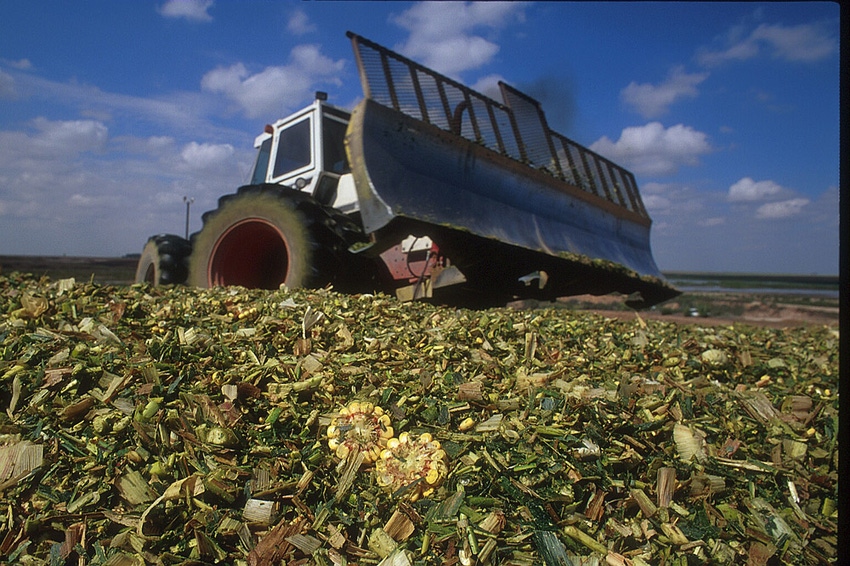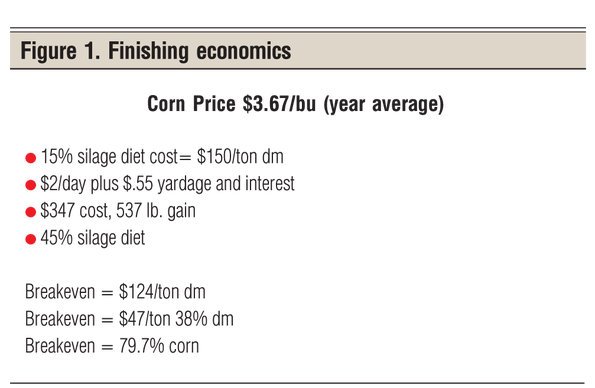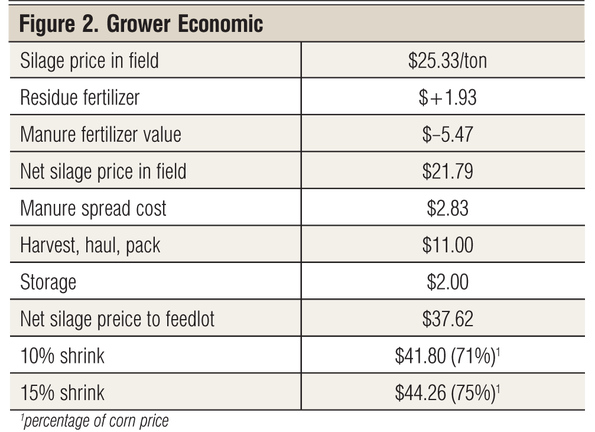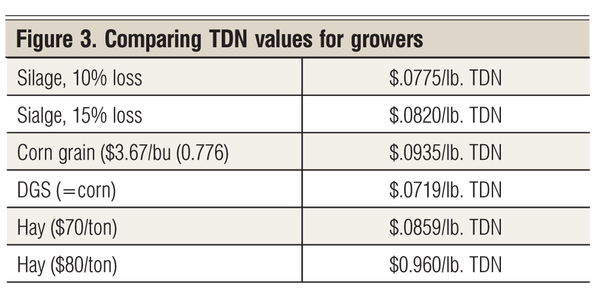Don’t discount corn silage as a go-to feedstuff.

Even with corn prices way down, good corn silage might be the top ration ingredient for many feeders and backgrounders this year.
That's a recent summary by Terry Klopfenstein, retired University of Nebraska animal scientist. Speaking at a silage conference in Nebraska earlier this summer, Klopfenstein said in the right scenario, silage can represent a better buy per ton of total digestible nutrients (TDN) than corn or hay.
Of course, it all depends on the many variables, he said.
Generally, he assumed the feedlot or backgrounder would be close to the fields to be ensiled, and also that manure would be hauled back out to the same fields once every four years to replace the extra nutrients removed by the silage, thereby cheapening the cost.
Klopfenstein said he and coworkers have conducted four finishing experiments where corn silage was fed at 15% of diet dry matter to supply roughage (about 7.5%) versus silage fed at 45%. The cattle fed 45% silage gained slower and less efficiently and took more days and more feed. They adjusted the days on feed to achieve the same total gain. These data were used for the economic calculations.
Silage price
Klopfenstein based silage price on the value of the corn grain in the field, and included a share of corn storage costs, which is about the normal price appreciation from harvest to beginning of the next production year. They also used April's futures price minus the basis for Nebraska, resulting in a net price in the field of $2.96, which puts the cost at $25.33 per ton of 38%-dry-matter silage. The corn price has fallen lower now, of course, but Klopfenstein says the relationships still hold.
Manure value back
Typically the value of the plant nutrients in the forage part of the silage is added to the price of the silage. However, in this case, Klopfenstein calculated putting those nutrients back on the fields, which nearly erases those added silage costs.
"When credit is given for the manure nutrients, the price of silage is 52% to 55% the price of corn, so silage would be very economical," he says. "However, the manure credit includes P at about four times the level needed for annual plant growth."
They considered three options, but said rotating fields each of the four years is most economical.
Finishing economics
In a nutshell, Klopfenstein said for finishing diets, if silage costs 80% the price of corn or less, it should be profitable to feed.
With silage priced at $25.33 per ton in the field and considering four ways of accounting for the manure credit and storage losses, the price of the silage into the feed trucks varied from 52% the price of corn to 80.4%.
"Accounting for the manure nutrients has a large effect on the cost of the silage," Klopfenstein said.

70+ photos showcasing all types of cattle nutrition
Readers share their favorite photos of cattle grazing or steers bellied up to the feedbunk. See reader favorite nutrition photos here.
In the finishing economics table (Figure 1), they calculated the breakeven for the 45% silage diet compared to the 15% silage diet. They priced corn at $3.67 per bushel, which is the average for the year including half the 47-cent price increase from fall harvest time. On the 15% silage diet, the cost for 537 pounds of gain was $347. The silage would need to be priced into the feed truck at 79.7% the price of corn to break even, Klopfenstein says.

Grower economics
Lighter cattle in the growing stage produce fewer manure nutrients, and that affects price and returns but still offers opportunities, he adds.
Silage priced to the feed truck is 71-75% the cost of corn, depending upon the amount of silage shrink.
The Grower Economics table (Figure 2) reflects the economics using the data from a recent growing experiment by Henry Hilscher, a UNL graduate student and feedlot manager. Cost of gain was 50 cents per pound with 10% silage shrink and 52 cents with 15% shrink.

Klopfenstein said because he did not have a control group, he calculated the cost per pound of TDN for several feedstuffs. Because distillers grains with solubles (DGS) has 130% the energy of corn in growing diets, it is the least expensive source of energy when priced equal to corn per pound of dry matter.
In Figure 3, you can see corn silage is 83% to 88% the price of corn. This suggests corn silage supplemented with DGS is an economical way to grow calves in a lot.

To download the program with all Klopfenstein's charts, including the manure-valuation options, click on this link. To watch Klopfenstein's presentation, click on this link.
You might also like:
Do small cows make more money?
13 utility tractors that will boost efficiency
How to get more value from your cull cows
14 thoughts to help get those heifers bred
Photo Tour: World's largest vertically integrated cattle operation
About the Author(s)
You May Also Like



